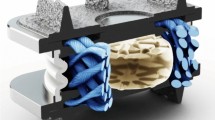Abstract
This study investigated the preoperative morphology and postoperative fusion of the atlanto-axial joint (AAJ) in patients with atlanto-axial subluxation (AAS) due to rheumatoid arthritis (RA) using computed tomography (CT). Furthermore, we examined the relationship between the preoperative morphology of AAJ and other radiographic results. Thirty patients with AAS due to RA treated by C1–2 transarticular screw fixation (TSF) were reviewed. The morphology of the AAJ was evaluated using sagittal reconstruction views on CT before and 1 year after surgery. Thereafter, the atlanto-dental interval (ADI) value at the neutral and maximal flexion position and atlanto-axial angle (AAA) at the neutral position was assessed in preoperative lateral cervical radiographs. The preoperative morphology of the AAJ on CT reconstruction views was graded as follows: Grade 1 showed maintenance of the joint space, Grade 2 showed the joint space narrowing and Grade 3 showed the destructive abnormality of subchondral bone. After surgery, the ADI value at the neutral position was assessed in lateral cervical radiographs. Furthermore, the fusion in the AAJ was investigated using CT sagittal reconstruction views taken 1 year after surgery. The preoperative CT image of the AAJ demonstrated Grade 1 in 12 cases (Group A), Grade 2 in 9 cases (Group B) and Grade 3 in 9 cases (Group C). There was no significant difference in age, gender and duration of RA among the three groups. The average ADI value at the flexion position was 11.0 mm in Group A, 12.3 mm in Group B and 12.7 mm in Group C (p > 0.313). The average ADI value at the neutral position before surgery was 4.5 mm in Group A, 7.3 mm in Group B and 11.4 mm in Group C (p < 0.003). The mean AAA value was 20.8° in Group A, 21.8° in Group B and 8.4° in Group C (p < 0.033). The average ADI value after TSF was 1.7 mm in Group A, 2.1 mm in Group B and 3.0 mm in Group C (p > 0.144). Fusion in the AAJ 1 year after surgery was demonstrated in 14 cases (46.7%; Group A, 0 case; Group B, 5 cases; Group C, 9 cases). According to the preoperative grading of the AAJ, the postoperative fusion in the AAJ was demonstrated in 0 of 32 joints (0%) in Grade 1, 7 of 18 joints (38.9%) in Grade 2 and all of 10 joints (100%) in Grade 3. In conclusion, this study showed that a destructive abnormality of subchondral bone in the AAJ induced an enlargement of the ADI and anterior inclination of the atlas in patients with AAS due to RA. The current study also showed that fusion in the AAJ was demonstrated in 14 of 30 patients after C1/2 TSF. This was easy to recognize in AAS patients whose joint destruction extended to the subchondral bone.




Similar content being viewed by others
References
Fujiya M, Oguma T, Hasegawa K, Oda I, Minami M, Matsuno S (2003) Long-term outcome of the operated cervical spine in rheumatoid arthritis: comparative study of cases with and without vertical subluxation (in Japanese). Rinsho Seikei Geka 38:427–435
Grob D, Jeanneret B, Aebi M, Markwalder TM (1991) Atlanto-axial fusion with transarticular screw fixation. J Bone Jt Surg Br 73:972–976
Grob D (2000) Atlantoaxial immobilization in rheumatoid arthritis: a prophylactic procedure? Eur Spine J 9:404–409
Iizuka H, Sorimachi Y, Ara T et al (2008) Relationship between the morphology of the atlanto-occipital joint and the radiographic results in patients with atlanto-axial subluxation due to rheumatoid arthritis. Eur Spine J 17:826–830
Ito H, Neo M, Fujibayashi S, Miyata M, Yoshitomi H, Nakamura T (2008) Atlantoaxial transarticular screw fixation with posterior wiring using polyethylene cable: facet fusion despite posterior graft resorption in rheumatoid patients. Spine 33:1655–1661
Magerl F, Seemann PS (1987) Stable posterior fusion of the atlas and axis by transarticular screw fixation. In: Kehr P, Weidner A (eds) Cervical spine I. Springer, Wien, pp 322–327
Matsunaga S, Sakou T, Onishi T et al (2003) Prognosis of patients with upper cervical lesions caused by rheumatoid arthritis, comparison of occipitocervical fusion between C1 laminectomy and nonsurgical management. Spine 28:1581–1587
McGraw RW, Rusch RM (1973) Atlanto-axial arthrodesis. J Bone Jt Surg Br 55:482–489
Wang C, Yan M, Zhou H, Wang S, Dang G (2007) Atlantoaxial transarticular screw fixation with morselized autograft and without additional internal fixation: technical description and report of 57 cases. Spine 32:643–646
Conflict of interest
No benefits in any form have been received or will be received from a commercial party related either directly or indirectly to the subject of this article.
Author information
Authors and Affiliations
Corresponding author
Rights and permissions
About this article
Cite this article
Sorimachi, Y., Iizuka, H., Ara, T. et al. Atlanto-axial joint of atlanto-axial subluxation patients due to rheumatoid arthritis before and after surgery, morphological evaluation using CT reconstruction. Eur Spine J 20, 798–803 (2011). https://doi.org/10.1007/s00586-010-1611-7
Received:
Revised:
Accepted:
Published:
Issue Date:
DOI: https://doi.org/10.1007/s00586-010-1611-7




